Six HR leaders share solutions to the issues keeping HR up at night: the impact of COVID-19, workforce planning, business agility, and the skills gap.
By Marta Chmielowicz
2020 has been a whirlwind of a year and HR leaders have found themselves at the frontlines, leading the charge into a new and uncertain reality. Throughout the COVID-19 pandemic, shelter in place orders, and social unrest of the past months, HR leaders have maintained a sense of normalcy while adapting to the changing needs of their businesses and the workplace at large. Now, they must develop a plan to face the unknown obstacles that lie ahead.
What are the top concerns on the minds of today’s HR executives as they look forward? HRO Today recently released a new report, the 2020 Top Concerns of CHROs study, that examined this very question. Results found that HR’s first priority in this tumulus time is the long-term impact of COVID-19 on company operations, with over one half (52%) reporting a high level of concern. Business agility is also top of mind among 81.4% of respondents, and the same number say that they now consider themselves more of a business executive than an HR manager.
These results reveal a profound truth: The role of HR has changed in light of this year’s many crises. HR leaders are expected to be the decision makers around all things talent, understanding how outside forces will affect the business and developing interventions to keep their company competitive and their employees engaged.
“COVID-19 has really brought the attention and capabilities of HR to the forefront as it relates to the health and wellness of our employees, retaining top talent, and making sure that from a stakeholder alignment perspective, the leadership, not only at the C-level but across the globe, is really focused on the critical priorities during these trying times,” says Gilma Saravia, chief people officer at IT company Altair.
What has emerged is a world of work that increasingly prioritizes employee well-being and individuality, as well as one that relies heavily on technology in its workforce planning, talent acquisition, and talent management processes.
Here, six HR leaders across industries ranging from healthcare to IT to banking share how they are adapting to the new normal and their priorities for the year ahead.
Supporting Individual Wellness
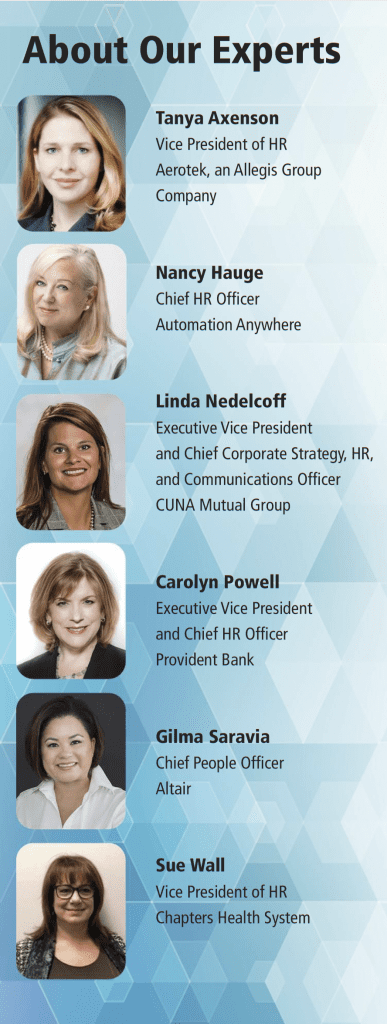 The majority of working Americans have been impacted to some extent by the COVID-19 pandemic, putting a spotlight on employee needs in the workplace. As the world processes the trauma of a global pandemic, HR leaders have had to rally around care: making certain that employees and their families feel safe and supported as they navigate the complexities of remote work.
The majority of working Americans have been impacted to some extent by the COVID-19 pandemic, putting a spotlight on employee needs in the workplace. As the world processes the trauma of a global pandemic, HR leaders have had to rally around care: making certain that employees and their families feel safe and supported as they navigate the complexities of remote work.
“When you deal with people in a remote environment like this, suddenly you don’t define them as employees who come into your workplace,” says Nancy Hauge, CHRO of Automation Anywhere. “It’s entirely different when you’re looking into their home, when their kids walk through a meeting, when you can see their spouse working next to them, when their dog or cat jumps in their lap during a call. Suddenly, you know you’re dealing with human beings and the human part of HR is what you have to lead with.”
According to HRO Today‘s survey, HR leaders’ foremost concern is meeting the needs of its workforce, with nearly one-half (41.2%) feeling extremely or very concerned and nearly every respondent expressing at least moderate concern.
For most HR teams, this means ensuring the health and wellness of their employees, families, and communities. Altair has taken the lead on employee health by investing in a calendar of information sessions and global wellness classes and programs, such as walkathons, yoga, and Pilates, that are available to employees and their families. According to Saravia, the company also offers special allowances and travel reimbursements for employees who rely on public transportation, giving them the opportunity to reduce their exposure to COVID-19 and limit the risk of infection.
In addition, organizations are increasingly viewing work as something to accomplish, not a place to go, and acknowledging the need for customized schedules and arrangements tailored to individual needs.
Aerotek, a recruitment agency in the Allegis Group network, has introduced flexible schedules and remote options that allow employees to balance their work with personal obligations such as childcare or virtual schooling. “We are focused on helping our employees feel supported as we all navigate these unprecedented times together by delivering the work model they need to be successful,” says Tanya Axenson, the company’s vice president of HR. “When you want your employees to perform to the best of their ability, you need to engage them individually -there isn’t a one-size-fits-all approach. Each employee’s circumstances are different and can change from day to day.”
Carolyn Powell, executive vice president and CHRO of Provident Bank, says that her company has also become much more flexible as a result of the shift to remote. Prior to COVID-19, Provident Bank did not have a formal remote work policy and was very much an in-person, in-office culture. But the pandemic has highlighted the need for an individualized approach to talent management as well as the importance of internal communications.
“The switch to remote work has helped our team members understand the need for knowing how to connect -different ways to connect with people, the comfort and the confidence to connect remotely, and what daily interaction looks like in a virtual environment. I think this will change the way people think about how they manage their staff,” she explains.
For example, at the beginning of the lockdown, the bank provided frequent how-to communications to ensure that employees were prepared to use the new virtual technology and offered resources and support to help them manage their stress and anxiety. While frequency has since dropped, this has led to a lasting, more intentional approach to company communications, with weekly meetings superseded by daily huddles and teleconferencing tools becoming the norm even as workers return to the office.
Sue Wall, vice president of HR at Chapters Health System, says that the enhanced role of communications in today’s workforce has completely transformed her role. “The pandemic has increased some barriers to effective collaboration, teamwork, and communication which are foundational to all efforts at being more agile or strategic. So, my role has shifted somewhat to include an even greater focus on the areas of communication in these stressful times; how we can effectively collaborate as team in a remote environment; and ensuring that we stay connected, aligned, and responsive to our internal customers and their needs.”
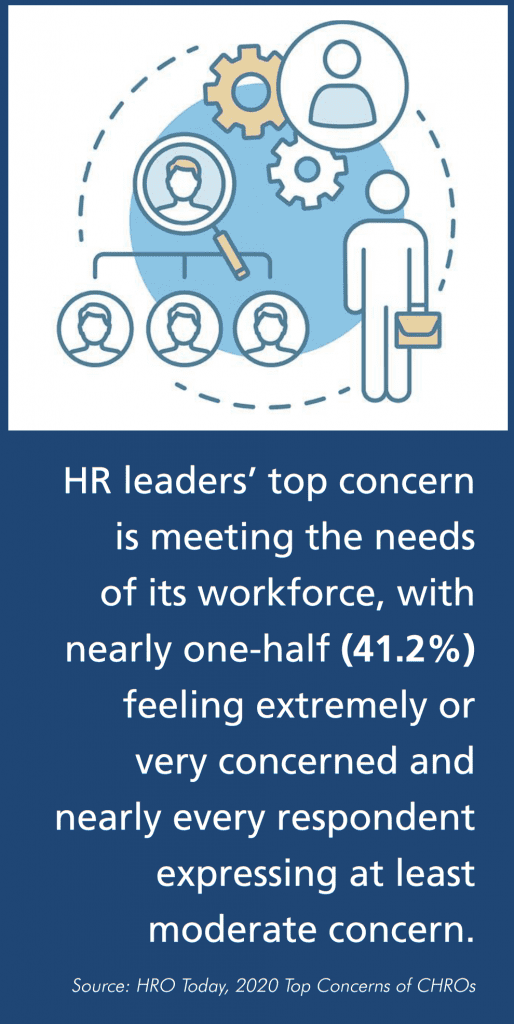 While maintaining an individualized approach to HR in the age of COVID-19 is an added challenge, doing so well can greatly enhance a company’s reputation and culture. According to Linda Nedelcoff, executive vice president and chief corporate strategy, HR, and communications officer at CUNA Mutual Group, navigating this new territory with an eye towards authenticity and values is key.
While maintaining an individualized approach to HR in the age of COVID-19 is an added challenge, doing so well can greatly enhance a company’s reputation and culture. According to Linda Nedelcoff, executive vice president and chief corporate strategy, HR, and communications officer at CUNA Mutual Group, navigating this new territory with an eye towards authenticity and values is key.
Her company has leveraged this year’s unrest as an opportunity to drive home its values of transparency, communication, and accessible leadership. Many of the virtual updates and events that came out of the COVID crisis have become a company staple; weekly CEO video calls and casual virtual coffee chats have brought the team even closer together than they were when they worked in the office.
“Interestingly enough, we’ve learned from our surveys that our workforce feels even closer to the leadership team than they did when many of us were in closer proximity, and that has happened because we launched off of something that is a natural part of who we are,” Nedelcoff says. “I think the organization feels like we are all experiencing this in a similar way, and so we are very empathetic towards one other. We are all in the same storm even if we’re on different boats.”
Driving D&I
A critical element of maintaining employee well-being is making sure that all employees feel respected and included in the company culture. According to HRO Today‘s research, only 20.7% of HR leaders considered diversity a high concern prior to this year’s social unrest, compared to 33.3% afterwards -a growth of 61%. However, less than one-quarter (22.5%) of organizations rank diversity as a key concern when preparing for future staffing needs.
While HR leaders recognize the importance of D&I, there is still much work to do. In fact, Hauge believes that issues of belonging and inclusion will be the biggest challenge in 2021.
“Nothing we have done in the past has done anything to solve this issue,” she says. “If we’re going to eradicate racism and bias in our work environment, we’re going to have to peer into the souls of people a little differently than we have before. We’re going to have to call it out in ways we’ve never done before. This is not over -this was not a fashion over the summer. That was the first tremor of an earthquake.”
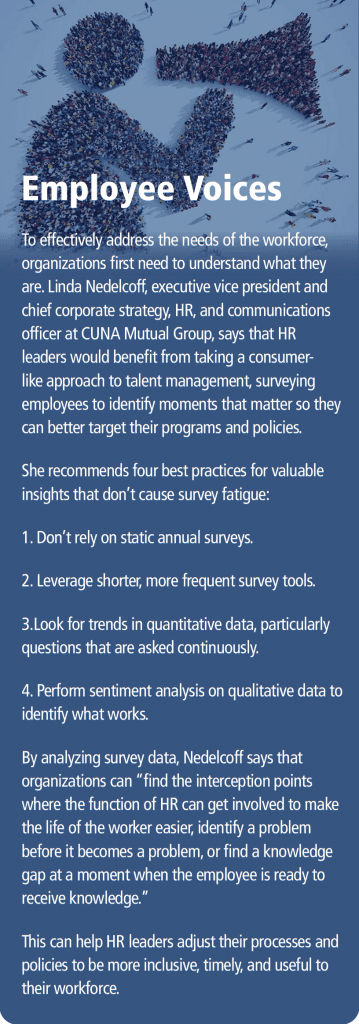 How are companies approaching D&I in a moment when the stakes are so high?
How are companies approaching D&I in a moment when the stakes are so high?
According to Hauge, the first step to creating a D&I program that actually works is listening to minority employees who have lived with the experience of racism or prejudice. She says Automation Anywhere is still in listening mode, learning from employees to better understand their struggles and develop interventions.
“The biggest shift is listening,” she explains. “Just listening and being thoughtful and not jumping to what you consider the right conclusion because often, what people choose as a solution is what they feel comfortable with. And I think the problem is that solutions here are going to make us uncomfortable and we’re going to have to learn to tolerate that.”
Provident Bank’s Powell says that her company has introduced town halls and listening sessions as a way to foster communication and inclusion. She has launched socially distanced dialogues between small groups of employees and the CEO on how race, diversity, and inclusion impacts their daily lives and what the organization can do to support them.
“This kind of in-person dialogue allows for a much freer flow of thoughts and presents a forum for sharing ideas,” says Powell. “We’ve brought together a cross section of people representing different areas of the bank with a passion to be diversity champions. These individuals will partner with HR to lead initiatives throughout the organization.”
With feedback that came out of these listening sessions, Powell’s team will be introducing two new diversity initiatives. First, the company is developing a robust, year-round, rotational internship program in collaboration with career development offices from local colleges and universities to give students a lens into a career in the banking industry. This program mirrors a broader initiative in the bank to offer mentorship and sponsorship programs that give diverse employees the support and coaching they need to advance their careers.
According to Axenson of Aerotek, these sorts of community partnerships can help support underserved populations, helping people reach their full potential through employment, education, and workforce empowerment while ultimately strengthening the communities where companies work.
The second initiative undertaken by Provident Bank is a webinar series that offers educational opportunities to empower women. Hosted by a women’s resource group called “ProvidentWomen,” the lunch-and-learn series is open to all female employees and introduces concepts around women’s career development and overcoming imposter syndrome. The company plans to continue fostering other employee resource groups (ERGs) in 2021.
According to Saravia, ERGs can help companies thrive in more ways than one. Altair’s newly established African American ERG created a community of support for Black employees, but also helped establish goals around recruitment, awareness, engagement, and pipeline development that guided the D&I program in the right direction.
Revamping Workforce Planning
COVID-19 has transformed nearly everything about the business world, and HR leaders have had to adapt their operations as well as their people strategies. Many companies are responding to the economic volatility with changes to the make-up of their workforce.
Prior to the pandemic, the 2020 Top Concerns of CHROs study reports that 39.8% of HR leaders planned to increase the size of their workforce in 2021, while just over one in 10 (11.9%) planned a decrease. Now, the percentage of leaders who anticipate a decrease has climbed to 38.5%, with significant variability across industries. For example, the entertainment and hospitality industries have been devastated by COVID-19, while technology, logistics, and telecommunications have prospered and grown.
Even businesses that have not suffered reductions in their workforce are dealing with changes in customer demand -and this has created a challenge of talent planning in a time of deep uncertainty. According to HRO Today research, over one-third (38.2%) of respondents feel extremely or very concerned about workforce planning.
Automation Anywhere has experienced this challenge firsthand. Suddenly, the company faced a surge in demand for its cloud-based products as clients struggled to maintain business continuity in the remote work environment, forcing an abrupt shift in needed skill sets across the organization.
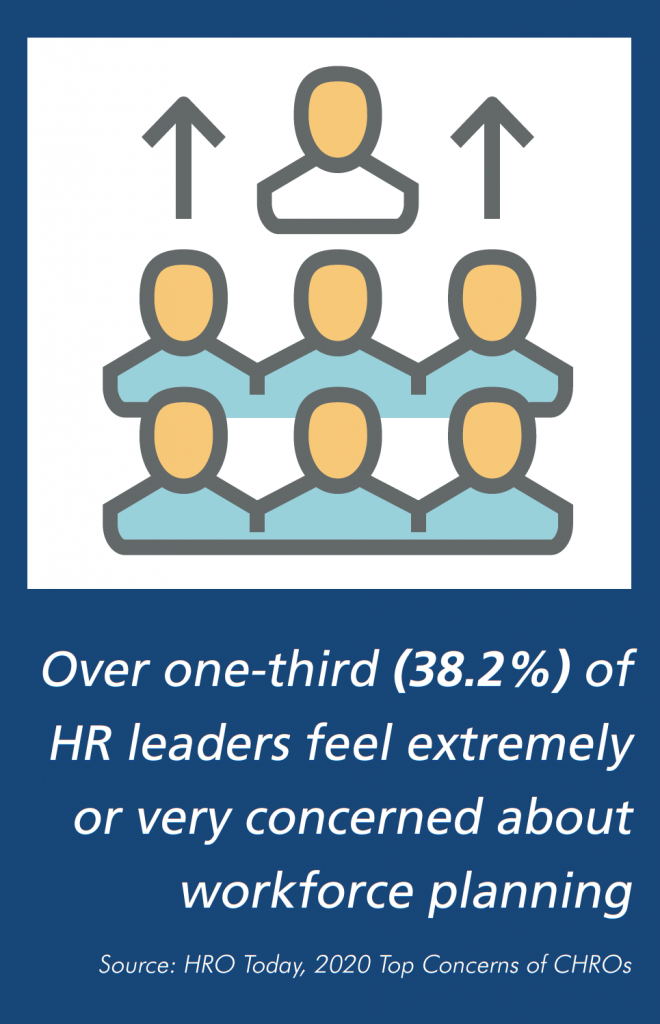 The financial services sector has also felt the impact; Provident Bank and CUNA Mutual had to close their brick and mortar facilities and transition to a virtual customer experience. Both organizations were left to navigate digital transformation and find new ways to deliver on their business needs.
The financial services sector has also felt the impact; Provident Bank and CUNA Mutual had to close their brick and mortar facilities and transition to a virtual customer experience. Both organizations were left to navigate digital transformation and find new ways to deliver on their business needs.
Powell says that the uncertainty of the pandemic has forced her company to rely on the use of data and analytics to predict customer behavior. “At the height of the pandemic, we saw a change in customer behavior from people coming into our branches to moving their activity online,” she explains. “By studying this data, we’re trying to understand whether this is a permanent shift or if we will see consumers returning to the branches at pre-pandemic levels as they become more comfortable.”
According to Hauge, Automation Anywhere has also relied on data, leveraging its artificial intelligence (AI) solutions to predict future talent needs. One tool that has been critical to its success is a bot that enables the talent review process. By analyzing manager questionnaires, employee feedback, and data from the HRIS system, the bot places each employee in a nine-box grid to reveal which talent is critical to the future of the organization, how they score on employee satisfaction, and interventions that could improve their retention chances. Some of the metrics built into the analysis include:
- employee performance;
- criticality of the role;
- cultural fit;
- employee flight risk;
- employee career development satisfaction; and
- employee preferences in a compensation package.
“Because we have a bot, not only can we do a very rigorous process, but we can do it incredibly quickly,” says Hauge. “I have access to information and visibility I’ve never had before. Using our own software, we’ve shortened the timespan from infinity to a matter of hours to get a very rich and robust look at our population -and not only how critical are they to us, but how critical we are to them. It also removes a lot of the subjectiveness out of the review process and makes certain that there’s more consistency.”
Leaning on Learning
Many companies are turning to learning solutions in order to fill the skills gaps revealed in their workforce planning efforts. According to HRO Today‘s report, the availability of skilled workers is a high concern for 37.4% of HR leaders, and 63% of HR leaders are turning to internal training versus hiring externally (18.5%) or establishing strong pipelines (17.4%) to fill any skills gaps.
Altair’s Saravia says the amplification of learning was natural for her organization, an environment where entrepreneurship, collaboration, and development is embedded in the DNA.
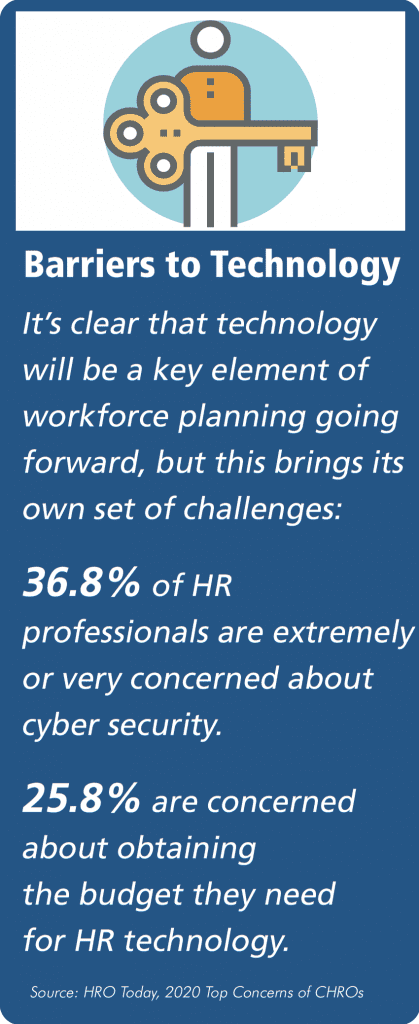 “In a way, we build our own curriculum pipeline internally,” she says. “We have engineers at all levels that host training sessions on their technical solutions, their discipline, or even key projects that they’re working on. And we have that entrepreneurial feel, so we push the boundaries and truly embrace the failures because that’s when we learn from our experience. Learning is not just done through training, but it’s also done through the phases of project development and collaboration.”
“In a way, we build our own curriculum pipeline internally,” she says. “We have engineers at all levels that host training sessions on their technical solutions, their discipline, or even key projects that they’re working on. And we have that entrepreneurial feel, so we push the boundaries and truly embrace the failures because that’s when we learn from our experience. Learning is not just done through training, but it’s also done through the phases of project development and collaboration.”
However, not all organizations have such a strong culture of learning engrained within their very operations. In fact, HRO Today reports that only about one-half (52.7%) of senior HR leaders feel their organizations have made significant or moderate progress in establishing an upskilling program that develops a mix of soft, technical, and digital skills.
Some companies, like Provident Bank and Chapters Health System, are adapting by leveraging online learning tools that can help increase their employees’ skills -particularly around the use of new technologies.
“We’re heavily investing in new technology in order to be able to serve the growth and expansion needs of Chapters. Much of our upskilling is in the area of these new technological tools so that we can implement them effectively and efficiently while still maintaining a focus on serving our patients, their families, and our employees. We also transitioned our in-person learning to a virtual classroom to ensure that we continue to develop and grow our talent,” says Wall.
Likewise, Provident Bank’s Powell says that her team has shifted to hosting interactive learning sessions on virtual platforms where employees can view each other’s screens. This is supplemented by a resource page of self-guided study materials that employees can access at any time, as well as a company-wide cultural shift to encourage self-driven learning.
She notes that the transition to virtual has actually opened up new opportunities. “Because so many conferences and in-person trainings got cancelled, money that was set aside for people to travel was redirected to open up training opportunities to more people. I think that’s actually going to be a long-term shift.”
Developing Talent Pipelines
Learning programs aren’t the only way to stay competitive in the post-COVID-19 business climate -organizations need to prepare for the bumpy road ahead by developing solid talent pipelines. But in this environment, HR leaders will need to get creative, designing safe alternatives to traditional approaches like on-campus hiring and summer internship programs.
The challenge of university recruitment was a major obstacle for Altair. According to Saravia, the company had to develop an entirely new university relations approach and internship proposition in order to attract the young talent it needs to drive innovation.
“For us, being a technology company, a pipeline of future innovators is very important in many aspects of our footprint,” says Saravia. “And the fact that universities are really restricting how we engage became pretty challenging. I had to get creative about how we hosted virtual internship programs and, most importantly, how we go to market to let students and professors know that we are hiring and that we want to engage in internships and also future positions.”
Altair responded by redesigning its internship program, incorporating professional training and a leadership curriculum in addition to its standard innovation project. While virtual, the new program design enhanced the internship opportunity by granting students a well-rounded experience that allowed them to participate in the collaborative company culture.
Nedelcoff had similarly positive results from her virtual internship program at CUNA Mutual. “We brought 60 interns in this summer virtually, and the feedback was incredible. They genuinely felt like they were leveraged, their skills and capabilities were stretched, they felt like they were able to provide meaningful value to the organization, they felt connected, and they felt like they got to know who we are as a company and our DNA.”
Looking Forward
There is no doubt that this year has been an immense challenge for companies and the HR leaders at their helm. COVID-19 has driven profound, multi-faceted changes in the workplace, but while shocking in their abruptness, many of these changes were not unexpected. Rather, they are the endpoints of trends that have been making inroads in the world of work for quite some time.
Digital transformation, business agility, user experience, employee wellness, continuous learning -none of these are novel concepts. In fact, according to Powell, they have been features in many companies’ long-term planning and regular dialogue.
“It isn’t just because of the events of 2020 that we’re changing -the world has been changing around us and this year has certainly accelerated a lot of existing trends. This is a journey; this isn’t just an event,” she explains.
To succeed in the uncertain world ahead, organizations will need to become proactive rather than reactive, predicting the future of work tomorrow and developing solutions today that will ease the transition.
“Going forward, we have to remain focused on the future of work and help employees and leaders understand what the workplace will look like in the coming years,” she adds. “That helps people connect the immediacy of what we’re doing today to the broader journey -and I think that’s going to be very important to continue to drive meaningful change.”













